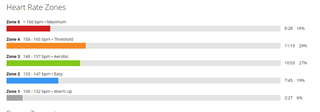It's my turn to ask for explanations about a Training Effect in some activities :D
https://connect.garmin.com/modern/activity/9657979342 Workout was "Threshold" but i got "VO2max" and it happened more than a few times. OK, i thought, i just pushed too much and my max HR or the average during the interval was higher than what's expected for "Threshold".
In fact, the explanation from Garmin is:
"Exerting intense aerobic effort above your lactate threshold during this activity is expected to improve your VO₂ Max. Nice job!"
Not a problem for me...still High aerobic, me still happy of the result and everyone's happy.
https://connect.garmin.com/modern/activity/9723932381
https://connect.garmin.com/modern/activity/9736679701
Similar activities...pace is not reliable but everything was a bit faster than targets(except the last minute of the 2nd activity where i slowed a bit and went probably 3-4 seconds slower than the target).
Saying that pace is not reliable doesn't look nice but in the first activity, for Garmin, it was underestimated and for the second activity it was overestimated but the final result is the same.
Is it just because it's a treadmill and we can close the case easily?
The explanation, from Garmin, "Exerting intense aerobic effort at or near your lactate threshold during this activity is expected to improve your lactate threshold." doesn't really make sense considering that both max and average HR were higher than during the outdoor example...as can be seen from the zones too, there were no changes in the lactate threshold between the 2 situations...at least not from Garmin
-----------------------------------------------------------------------
https://connect.garmin.com/modern/activity/9117962583 nice those times when getting Anaerobic TE was pretty easy.
https://connect.garmin.com/modern/activity/9700174222 lower(a lot lower) temperatures and i get a "Base" primary TE.
I would say that i should bring my HR a bit higher? But how am i supposed to do it considering that i'm already 15 seconds faster than the target?
I still got a lot of Anaerobic effect and a decent amount of load but it's not the same because getting a PE "Base" or "Tempo" gives also "Low aerobic" or "High aerobic" load.
For "Sprint", i rarely have any issue...the only one that i got different was the following https://connect.garmin.com/modern/activity/9089910518 where i got "Tempo" instead of "Sprint" but the explanation looks straightforward....hot weather and high HR in between of intervals.
Waiting for advices










